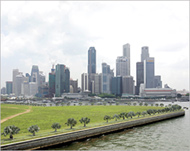Did China find America?
Few history theories stir as much controversy as Gavin Menzies’ idea that a legendary Chinese admiral discovered America, seven decades before European explorer Christopher Columbus.

Although many historians dismiss the former British naval officer’s theory, including some from China, the predominantly ethnic Chinese city-state of Singapore may give it a new sheen of respectability during a three-month exhibition beginning in June.
Menzies, author of the bestseller 1421: The Year China Discovered America, says Admiral Zheng He led a fleet of 30,000 men on board 300 ships to the American continent in the 15th century to expand China’s influence during the Ming dynasty.
Zheng, says Menzies, drew up maps later used by Columbus to reach America in 1492 while searching for a new route to India.
Portuguese explorer Ferdinand Magellan also sailed with the help of Chinese-drawn maps in the 16th century, he adds.
Outdoing Columbus
“None of the great explorers discovered anything new. They all had master maps that were charted by the Chinese,” said Menzies, a 67-year-old former British submarine commander who spent about 15 years researching his 490-page book.
 |
|
Singapore is to host an exhibition |
The government-funded Singapore Tourism Board is one of several groups backing the 10 June to 11 September outdoor exhibit at the Marina Promenade, which organisers say will unveil “new information and evidence” in support of the theory that Zheng landed in America before anyone else.
The 1421 Exhibition, organised partly by Menzies himself, will also include details of a naval base which Zheng is believed to have established in Canada at a geographical site known as Nova Cataia or New Cathay, said one organiser.
Pico Art International of Singapore will also stage celebrations this year marking the 600th anniversary of Zheng’s maiden voyage through Southeast Asia, when he arrived in the port of Malacca, on the west coast of modern-day Malaysia, as the Chinese emperor’s envoy.
The festivities will pay tribute to a man renowned in Chinese history as the country’s greatest naval commander.
Rewriting history
But whether Zheng – a Muslim eunuch known to have sailed as far as southern Africa – beat Columbus to America by a comfortable 71 years is bitterly debated.
|
If true, it would rewrite history books and could cause deep soul-searching in American schools.
“It’s rubbish,” said Geoff Wade, a senior fellow at the Asia Research Institute of the National University of Singapore. “There is no evidence to back it up.”
Historical records show that from 1405 to 1433, Zheng, under the orders of Ming Emperor Zhu Di, led China’s imperial Star Fleet on seven epic voyages.
Along with its 30,000 men, the fleet, the biggest of its time, carried the hopes of an ambitious emperor seeking to expand China’s influence.
Historical records show that Zheng, on one trip, returned from Africa with a captive giraffe as a gift to the emperor.
According to Menzies, he accomplished far more. Menzies says Zheng also took his fleet to America and around the globe.
“There is absolutely no doubt whatsoever that Zheng He’s fleet did indeed reach both the Atlantic and Pacific coast of North and South America,” he said.
Some scholars, including Chinese academics, reject the idea as hopeful fiction. “I would be very delighted if his theory is true but his work has got nothing to do with scholarship,” a Chinese historian with a Singapore university said.
“There is no methodology in his research and no support for his arguments. He makes conjectures and suddenly they become facts.”
Chinese maps
Menzies, who joined the British navy at 16, admits he is no academic but insists on the authenticity of his work.
|
Given China’s formidable naval power in the 15th century, when some historians say China boasted the world’s biggest maritime fleets, only the Chinese could have charted the master maps that led European explorers around the world, said Menzies.
Historical records show Zheng He’s largest wooden junk was 130m long and 60m wide, powered by nine masts of sail and manned by at least 500 men.
That makes it nearly four times bigger than Columbus’s biggest ship, the Santa Maria.
Menzies cites research which he says shows the DNA of native Americans is closer to that of Chinese than Europeans or Africans. This, he says, supports his theory that some members of Zheng’s fleet stayed behind in America and started families.
“The people who live today in places where the Europeans found Chinese people in North America, those people have essential Chinese DNA in their blood,” said Menzies.
“The whole world owes Zheng He a huge debt.”